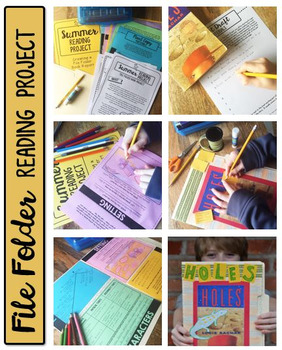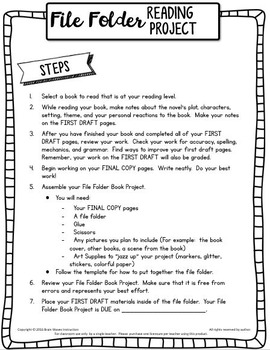Independent Work Book Report, File Folder Reading Project, Book Project
- PDF
What educators are saying
Description
This Common Core aligned Book Report Project enables students to creatively respond to their reading. Over the course of the book project, students will create a unique file folder covered in plot details, character analysis, setting description, a personal reflection, plus a book cover design and a listing of other books by the same author.
The File Folder Reading Project is designed for students to complete on ANY FICTION BOOK. The highly detailed handouts and worksheets in this resource are designed so that students can either work on the project in class or completely independently outside of the classroom. Students are required to complete a first draft of all project elements so that the final project reflects their best work. The end result is a vivid, comprehensive, and creative book report!
This project is easily adaptable for use as a response to a class-wide novel study, independent reading project, or summer reading project.
Also, the final file folders are a great addition to your classroom library. Future readers can easily reference the file folders to get a review of a book before reading the book on their own.
Step-by-step guides and directions are included for students. Worksheets and handouts for completing the hands-on book report project are part of this resource.
Skills developed with this book report project:
- Developing an understanding of a variety of genres
- Comprehension and analytic skills
- Plot, setting, theme and character analysis
- Critical thinking
- Editing and revising written responses to improve content and organization as well as spelling, grammar and punctuation
This detailed project includes:
- Teacher Project Overview including extension ideas
- Student Packet with detailed instructions and guides:
- File Folder Book Project Overview
- How-to Instructions on assembling the project
- First Draft - Plot Diagram
- First Draft - Character Analysis
- First Draft - Setting Details
- First Draft - Personal Reflection
- First Draft - Books by the same author
- First Draft - Cover Design
- Final copy cut-out resources - Plot, Character, Setting, Reflection
Common Core Aligned Project:
- RL.1, RL.2, RL.3, RL.6, RL.10
- W.3, W.4, W.5, W.6, W.10
- L.1, L.2, L.3, L.5, L.6
You may also like…
- Doodle Book Report - Students complete a book report in a fun doodle-style template
- Reading Comprehension Skills - Mini-Unit SUPER BUNDLE! - Making Inferences, Main Idea, Predictions, Sequencing, Cause and Effect, and Context Clues
- Poetry Reading, Writing, and Analyzing BUNDLE!
- Poetry Analysis Unit
Following is Fun!
Get the inside scoop on all store discounts, free products, and product launches. Just click the green “Follow Me” star under my store name on this page or click the green “Follow Me” star on my store homepage.
Let’s Stay in Touch!
*** Click HERE to receive the Brain Waves Instruction Newsletter filled with exclusive FREEBIES and Teaching Tips!
Thanks!
Brain Waves Instruction





